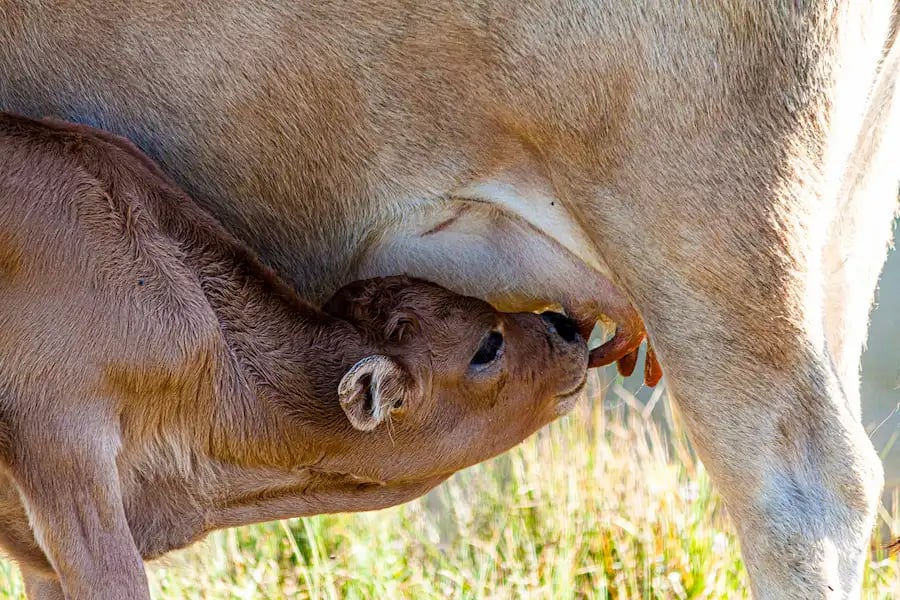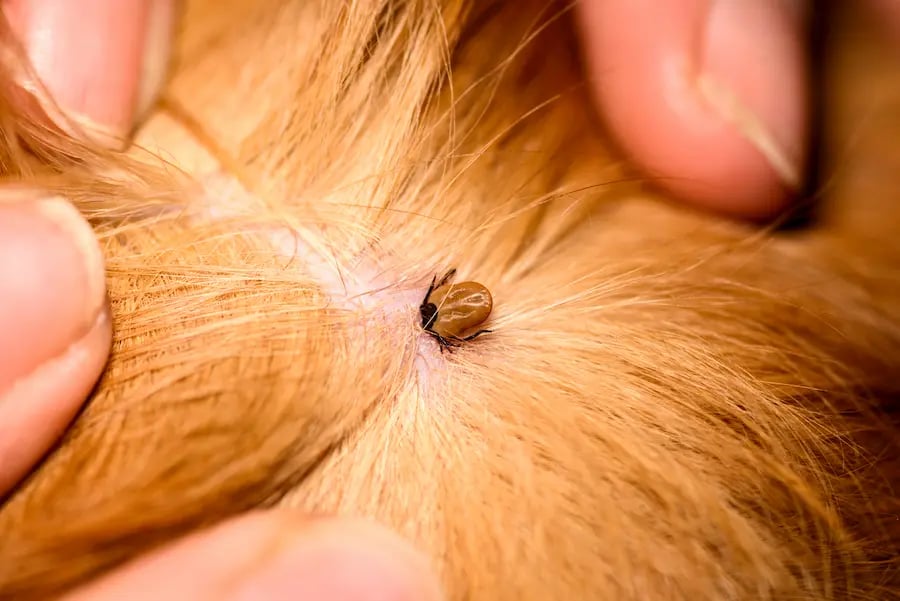Q fever is a contagious bacterial disease. A contaminated animal may be responsible for Q fever transmission to another animal close to it, or to a human. But Q fever transmission can also be indirect. As the epidemiology of the disease is complex and the virulent materials diverse, several transmission routes are possible.
What virulent materials are responsible for Q fever transmission?
Ruminants shed the bacterium by various routes.: in feces and, in the case of females, through vaginal discharge and milk. However, the materials that contain the most bacteria are fetal annexes (placenta, amniotic vesicle, etc.) and fetuses in the event of abortion.
In males, the bacteria can also be excreted in semen.
Placenta, foetal annexes and aborted fetuses
This is by far the most contaminated virulent material and therefore the most dangerous. When a female is a carrier of the disease, she can shed huge quantities of bacteria during parturition or abortion. It has been shown that in ewes, up to 109 bacteria can be present in each gram of placenta. This figure should be compared with the very small quantity of Coxiella burnetii needed to infect an individual. According to some studies, the inhalation of only 10 bacteria can be the cause of an infection (Rousset et al., 2007).
Vaginal fluids
As with fetal annexes, vaginal mucus and uterine secretions can be contaminated, particularly in the days following parturition.
Faeces
Although the quantity of bacteria shed in feces is less than in fetal annexes, fecal shedding is also a major source of Q fever transmission. Although this excretion is intermittent, as with other routes (Guatteo et al., 2007), the animals defecate every day and several times a day! The result is lasting contamination of the environment (Alvarez-Alonso et al., 2020).
Milk

Milk is also a virulent material, but its role in spreading the disease must be considered minor. Since contamination occurs essentially by inhalation, the risk of creating an aerosol from milk is minimal. Milk cannot therefore be considered to be responsible for Q fever transmission. In humans, an epidemiological study carried out among dairy farm workers in Hungary showed that among all categories of workers, seroprevalence was lowest among parlor workers (Dobos and Balla, 2021).
However, the presence of the bacterium in milk, and in particular in bulk tank milk (BTM), is useful for herd diagnostics using PCR.
Semen
Coxiella burnetii may be excreted in semen. However, unlike in humans or mice, sexual transmission has never been demonstrated in ruminants. Furthermore, in the case of artificial insemination, the rigorous control of breeding bulls, the very small quantity of semen contained in a straw and the presence of preservatives make transmission of the disease highly unlikely.
Inhalation is the main route of Q fever transmission
Animals and humans are almost exclusively contaminated by inhalation. Because of its latent form (Small Cell Variant or SCV), the bacterium is very small. It can therefore easily be suspended in the air or attached to fine dust particles, for example. Within a farm, transmission from an excreting animal to a non-infected animal is therefore facilitated by this property.
In addition, the SCV form can easily be carried by the wind, especially in dry weather. It has been shown that it can be carried up to 18 km (Hawker et al., 1998). A human population or an uninfected farm within this perimeter could therefore be contaminated.
What about the other routes
Oral
From a theoretical point of view, oral contamination is possible. However, the quantity of bacteria required to trigger the disease and seroconversion is very high. Experimentally, in mice, 105 bacteria given by oral gavage did not trigger an immune response, clinical signs or excretion of Coxiella burnetii. In comparison, an aerosol containing only 1000 bacteria was sufficient to trigger the disease (Miller et al., 2021).
Veneral
As explained above, the venereal route should not be considered as a major mode of transmission of the disease. Indeed, although sexual transmission of Q fever has been established in humans (Milazzo et al., 2001) or experimentally demonstrated in mice (Kruszewska and Tylewska-Wierzbanowska, 1993), no study to date has been able to demonstrate this route of contamination in ruminants.
However, if we are cautious, we can assume that venereal contamination cannot be ruled out. But even if it does exist, its role in the contamination of females can only be minimal compared with airborne route.
Ticks

Q fever is also a tick-borne disease. A correlation has been shown between the presence of ticks and the risk of infection on a sheep farm (Bauer, 2022). However, in this study, the number of ticks carrying Coxiella burnetii was very low and therefore cannot explain the spread of the disease in the flock.
Vector transmission is therefore a minor route of Q fever transmission (Duron et al., 2015).
Key messages
- The main contamination route is airborne.
- Placenta and other foetal annexes as well as aborted fetuses are highly contaminated materials.
- Coxiella burnetii can be transported by wind up to 18 kilometers
References
Álvarez-Alonso, R., Zendoia, I. I., Barandika, J. F., Jado, I., Hurtado, A., López, C. M., & García-Pérez, A. L. (2020). Monitoring Coxiella burnetii infection in naturally infected dairy sheep flocks throughout four lambing seasons and investigation of viable bacteria. Frontiers in Veterinary Science, 7, 352.
Bauer, B. (2022). Epidemiology and Control of Coxiella burnetii in Small Ruminants: a One Health Approach.
Dobos, A., & Balla, E. (2021). Industrial dairy cattle farms in Hungary source of Coxiella burnetii infection in humans. Vector-Borne and Zoonotic Diseases, 21(7), 498-501.
Duron, O., Sidi-Boumedine, K., Rousset, E., Moutailler, S., & Jourdain, E. (2015). The importance of ticks in Q fever transmission: what has (and has not) been demonstrated?. Trends in parasitology, 31(11), 536-552.
Guatteo, R., Beaudeau, F., Joly, A., & Seegers, H. (2007). Coxiella burnetii shedding by dairy cows. Veterinary research, 38(6), 849-860.
Hawker, J. I., Ayres, J. G., Blair, I., Evans, M. R., Smith, D. L., Smith, E. G., ... & Wood, M. J. (1998). A large outbreak of Q fever in the West Midlands: windbourne spread into a metropolitan area?. Communicable disease and public health, 1, 180-187.
Kruszewska, D., & Tylewska-Wierzbanowska, S. K. (1993). Coxiella burnetii penetration into the reproductive system of male mice, promoting sexual transmission of infection. Infection and immunity, 61(10), 4188-4195.
Milazzo, A., Hall, R., Storm, P. A., Harris, R. J., Winslow, W., & Marmion, B. P. (2001). Sexually transmitted Q fever. Clinical infectious diseases, 33(3), 399-402.
About the author
Philippe Gisbert (Ruminants Global Technical Manager)
Philippe Gisbert started his career in 1994 as a Vet practitioner working with companion and farm animals for over 9 years. He then became Health Affairs Manager for Group Agena (artificial insemination company). In 2008 he joined Eurofins – Laboratoire Coeur de France as Animal Health Unit Manager where he worked for 7 years until he joined Ceva France as Technical Manager Ruminants (Infectiology, Vaccines and Diagnostic). Since 2020 he is Global Technical Manager for Biologicals, Udder Health and Antiinflammatories. He is a member of SIMV diagnostic and anti-infective technical groups and has integrated different working groups of ANSES and UNCEIA related to epidemiology, antibiotic resistance and reproduction in livestock.
Explore author’s articles

Leave your comments here